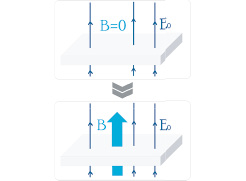Axion Electrodynamics and Condensed Matter
H. Ooguri and M. Oshikawa
Condensed matter physics and high-energy physics deal with phenomena at very different scales. Nevertheless, surprisingly often we encounter similar mathematical structures in these two different subfields of physics. Indeed, those encounters have been very fruitful for new developments in physics: notable examples include Nambu’s development of spontaneous symmetry breaking in field theory with a hint from superconductivity, and Wilson’s renormalization group unifying critical phenomena and field theory. Very recently, application of AdS/CFT correspondence to condensed matter is actively pursued. The foundation of IPMU (Institute for Physics and Mathematics of the Universe, now Kavli IPMU) in 2007 and opening of its building next to ISSP in 2010 provides a great opportunity for ISSP. In 2010, IPMU and ISSP co-hosted a workshop “Condensed Matter Physics Meets High-Energy Physics” to stimulate exchanges between the two fields.

Fig. 1. The phase transition of the “axion” field takes place under an applied electric field E0 above the critical value. It results in a spontaneous generation of magnetic field, even though no magnetic field is applied externally. (Figure drawn by Euan McKay and Azusa Minamizaki, reprinted from Todai Research Editor’s Choice: http://www.u-tokyo.ac.jp/en/todai-research/editors-choice/theory-of-undiscovered-elementary-particle-applied-to-topological-insulator/ )
Here we report on a recent joint research [1] between the two institutes. “Axion” is a hypothetical elementary particle, which has not yet been detected experimentally, but could be a key to solve mysteries in high-energy physics and cosmology. Recently, instability of axion field in the presence of strong electric field has been pointed out in high-energy physics. While the original axion as an elementary particle would not directly appear in condensed matter, it was pointed out [2] that doping of magnetic ions to a topological insulator results in fluctuating magnetic moments, which could be described by a similar field theory as the one of axions. We investigated the instability of the “axion” field in the condensed matter realization. It also led to a understanding of the physical mechanism of the instability, and to the clarification of the final state reached as a result of the instability. Above a critical electric field, magnetic field is spontaneously generated, and the excess electric field is screened by the effective surface charge induced by the deformation of the “axion” field and the magnetic field.
References
- [1] H. Ooguri and M. Oshikawa, Phys. Rev. Lett. 108, 161803 (2012).
- [2] R. Li, J. Wang, X.-L. Qi, and S.-C. Zhang, Nature Phys. 6, 284 (2010).
